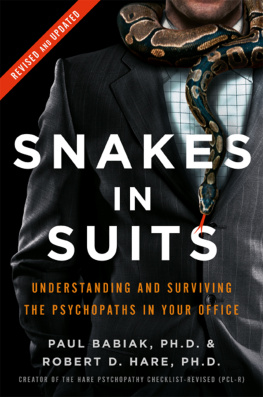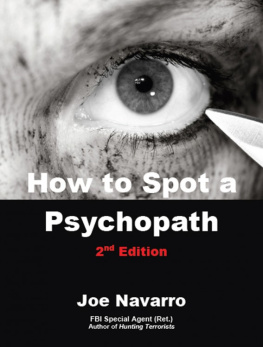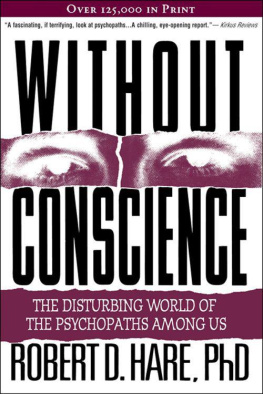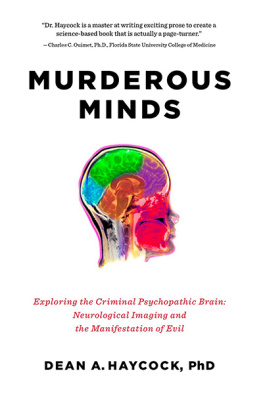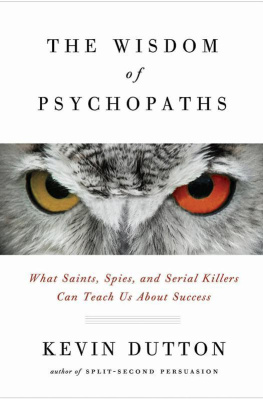Table of Contents
Landmarks
In the twenty-five years since I met my first corporate psychopath, a considerable amount of research has provided answers in response to many pressing questions. Based upon interesting case studies and exploratory theories of psychopaths behaviors, we now have a field rich with applied research that continually advances our understanding of how these invisible human predators operate. Formerly skeptical organizations are now deeply interested in studying those rare but dysfunctional individuals who would undermine the success of these organizations in increasingly chaotic times. In this second, revised and updated edition of Snakes in Suits , we integrated the most important research findings that have contributed to our understanding.
After more than twenty-five years of collaboration and friendship, working with Bob on this second edition has only strengthened my respect for his scientific rigor, subtle wit, warm sense of humor, and genuine human kindness. Clearly, no one understands the mind of the psychopath as does Bob.
We thank John Silbersack, our agent, who helped us turn a rough manuscript about a somewhat controversial topic into a finished product, both the first time around and now for a second edition. Rebecca Raskin, our editor at HarperCollins, has been instrumental in helping us integrate the new research into this expanded edition; we appreciate her patience and diligence.
We are also thankful to the many readers of the first edition who contacted us to share their own stories of psychopaths in their professional lives. Many of their insights reaffirmed our thoughts about how psychopaths operate in organizations and deepened our understanding of the more nuanced tactics psychopaths use. It has been very rewarding to work with some readers toward resolution of their personal situations. I can say that it is possible, with diligence, to overcome the psychopath in ones life despite the odds against this outcome.
I am indebted and forever grateful for the support of Joan, my wife, friend, and life partner, who made writing this second edition far easier than I had expected by unselfishly giving me the love, support, and encouragement I needed at a time when there were more pressing issues of life to deal with at home. Her love for life, open acceptance of people of all kinds, and deep understanding of the human mind made every day an adventure. I am forever grateful for her undying love; I miss her every day.
Paul Babiak,
New York, 2019
During my years of research on psychopathy, I have had the privilege of working with many outstanding students and colleagues. I thank them all. Particularly helpful in writing this book were Drs. Cynthia Mathieu, Craig Neumann, Dan Jones, and Andreas Mokros. Since I began work in this area five decades ago, things have changed dramatically. Instead of a few academics and clinicians working in isolation, there now are many hundreds of researchers around the world, many in contact with one another and all dedicated to understanding the nature and implications of psychopathy for society. A significant event was the 2005 formation of the Society for the Scientific Study of Psychopathy (SSSP), an organization that does much to facilitate international and interdisciplinary collaboration in the study of psychopathy and its impact on society.
Scientific research and debate and their applications to mental health and criminal justice certainly are important, but at the same time, the public must learn as much as it can about psychopathy. It was for this reason that I wrote Without Conscience: The Disturbing World of the Psychopaths Among Us. While writing the book, I had my first discussions with Paul Babiak. He had provided me with a case study that I included in a chapter on White Collar Psychopaths. Since then, I have had the great pleasure of working with Paul, as a colleague and friend, on a number of projects, one of which is this book. His vast and insightful experience as an industrial-organizational psychologist is evident in every chapter of this volume.
I would like to thank Kylie Neufeld, who, for two decades, was invaluable for her able assistance with my research and writing, for organizing and maintaining my web page, and for her work with Darkstone. Our agent, John Silbersack, provided wise counsel during our work on this and the first edition of the book. We thank him for his guidance and efforts on our behalf. We owe a special debt to our editor, Rebecca Raskin, for her insightful editing and her cogent comments and suggestions, and for her patience in dealing with our tardiness in submitting the final product.
My wife and best friend, Averil, for more than five decades, continues to provide me with a loving, nurturing environment, sound counsel, trenchant insights, and enlightened debates about things of importance. Her career as a social worker, field consultant for child abuse, neglect, and Director of Inspections and Standards for the BC Ministry of Family Services brought her into daily contact with the best and worst of people and situations. Her experiences and our discussions had a great influence on my work.
Our late, beloved daughter, Cheryl, who was admissions officer for the Faculty of Medicine at UBC, taught us much about courage, dignity, and grace in the face of adversity. She remains deeply embedded in our hearts.
Robert D. Hare,
Vancouver, 2019
Without Conscience:
The Disturbing World of the Psychopaths Among Us
Early Days
In Without Conscience , Hare (p. 1) referred to an article that he and his students had submitted to the journal Science . The editor rejected the submission with the following comment: Frankly, we found some of the brain wave patterns depicted in the paper very odd. Those EEGs [electroencephalograms] couldnt have come from real people. Actually, they came from a sample of psychopathic offenders who took part in a laboratory study of behavioral and brain responses to letter strings flashed briefly on a computer screen. The letter strings were neutral, positive, negative, and nonwords. The participant had to press a button as quickly as possible if what he saw was a word. Most participants responded more quickly, and exhibited larger and more prolonged brain responses (event-related potentials; ERPs), when the words were emotional than when they were neutral. Psychopaths, on the other hand, responded to all words as if they were neutral.
Fortunately, another major journal published the study,
Neuroimaging
In the early 1990s, Joanne Intrator, newly in charge of a brain-imaging unit at the Bronx Veterans Affairs Medical Center, and Hares group conducted what may have been the first imaging study of psychopathy, with substance abuse patients rated on the PCL-R as participants. Injection of a radioactive tracer allowed the researchers to determine which parts of the brain became most active during the task, based on Williamson et al. The results clearly indicated that psychopathic patients used relatively little emotional resources, and different parts of the brain, to process neutral and emotional words. An intriguing finding was that while processing emotional words the psychopathic patients showed unusual activation in areas of the brain associated with semantic and decision-making processes.
In the mid-1990s, one of Hares graduate students, Kent Kiehlnow a major player in the neurobiology of psychopathycoordinated collaborative research among Hares lab, Peter Liddle in psychiatry, and Bruce Forster in radiology. The result was the first in a series of functional magnetic resonating (fMRI) studies that showed that the parts of the brain associated with emotional processing had little impact on the language, cognitions, and behaviors of psychopaths.
Overview of Current Findings

